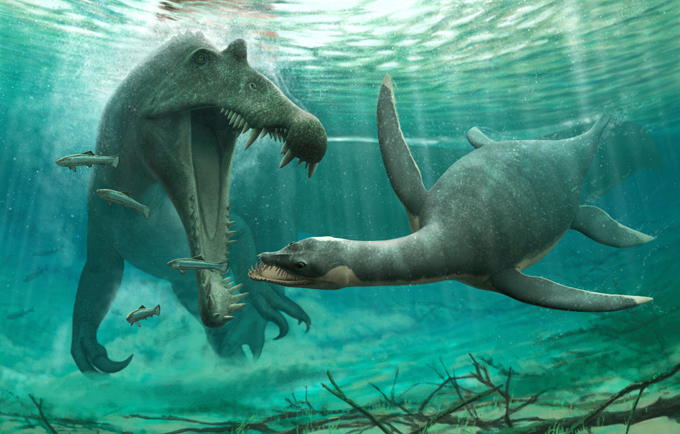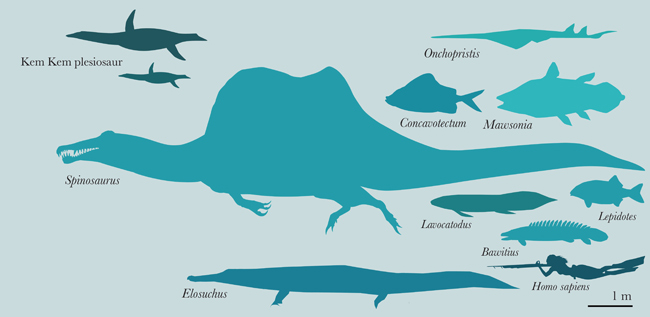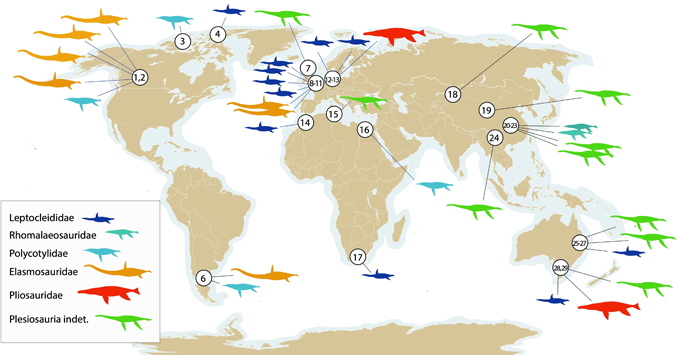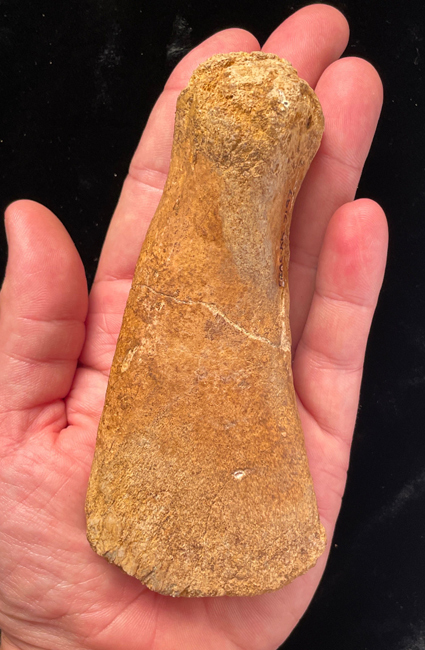Plesiosaurs Swam Alongside Spinosaurus According to New Research
Plesiosaur fossils found in strata associated with a 100-million-year-old river system prove that some plesiosaurs, traditionally thought to be marine animals, may have lived in freshwater. These long-necked, piscivores co-existed with the giant dinosaur Spinosaurus (S. aegyptiacus).

Freshwater Plesiosaurs
Scientists from the University of Bath and University of Portsmouth in the UK, and Université Hassan II (Morocco), have reported evidence small plesiosaurs from Kem Kem Group deposits in Morocco.
The fossils include bones and teeth from three-metre-long adults and an arm bone (humerus) from a 1.5- metre-long juvenile. They hint that these creatures routinely lived and fed in freshwater, alongside frogs, crocodiles, turtles, fish, and the huge aquatic dinosaur Spinosaurus.
When is a “Marine Reptile” a Marine Reptile?
The Plesiosauria clade was a long-lived and widely distributed group of marine reptiles. Most fossils, which date from the Upper Triassic to the end of the Cretaceous (Maastrichtian faunal stage), are associated with marine deposits, but a few specimens have been found in strata associated with brackish and freshwater environments. The researchers report plesiosaurs from river deposits of the Kem Kem Group. The numerous shed teeth show heavy wear similar to that observed in in the teeth of coeval spinosaurids. Contemporary plesiosaur fossils from the Bahariya Formation of Egypt have been identified as examples of the Polycotylidae plesiosaur family.
Kem Kem Fossils
The Kem Kem fossils probably represent leptocleidid plesiosaurs. Most Leptocleididae fossils come from shallow nearshore, brackish or freshwater palaeoenvironments suggesting that these small-bodied plesiosaurs were adapted to shallow, low-salinity environments.

As the fossil plesiosaur teeth show the same signs of wear as the teeth of Spinosaurus, the researchers imply that the plesiosaurs were eating the same food – chipping their teeth on the armoured fish that lived in the river. This indicates that they spent a lot of time in the river, rather than being occasional visitors.
As other types of Mesozoic marine reptile (mosasaurids and the crocodile-like teleosaurids), are thought to have inhabited (at least some of the time), freshwater environments, this suggests that so-called “marine reptiles” may have thrived in non-marine habitats.
Co-author of the scientific paper, Dr Nick Longrich (University of Bath Milner Centre for Evolution), commented:
“It’s scrappy stuff, but isolated bones actually tell us a lot about ancient ecosystems and animals in them. They’re so much more common than skeletons, they give you more information to work with. The bones and teeth were found scattered and in different localities, not as a skeleton. So, each bone and each tooth is a different animal. We have over a dozen animals in this collection.”
Diverse and Varied Kem Kem Group Freshwater Fauna
While extant marine mammals like whales and dolphins wander up rivers, either to feed or because they are lost, the number of plesiosaur fossils in the river deposits suggest that is unlikely. The team identified cervical, dorsal and caudal vertebrae, lots of teeth and the humerus from a juvenile. The researchers postulate that the plesiosaurs were able to tolerate fresh and salt water, like some whales, such as the beluga whale (Delphinapterus leucas).
Co-author Dr Samir Zouhri said:
“This is another sensational discovery that adds to the many discoveries we have made in the Kem Kem over the past fifteen years of work in this region of Morocco. Kem Kem was truly an incredible biodiversity hotspot in the Cretaceous.”

Plesiosaurs – Freshwater Incursions
The researchers compiled a list of all the geological formations that have shown evidence for the presence of members of the Plesiosauria clade in brackish or freshwater. Having collated this information, they re-examined the data identifying the different types of plesiosaur associated with the deposit.
As a result, a map documenting the incidences of freshwater incursions by different plesiosaur types was produced.

For the key to the geological formations see the end of this article.
Co-author David Martill (University of Portsmouth) exclaimed:
“What amazes me is that the ancient Moroccan river contained so many carnivores all living alongside each other. This was no place to go for a swim.”
Plesiosaurus Swam Alongside Spinosaurus
Key to the Geological Formations Featured in the Plesiosaur Map
Geographic distribution of non-marine Plesiosauria Formations: 1, Dinosaur Park Formation (Campanian); (2), Horseshoe Canyon Formation (Campanian – Maastrichtian); 3, Isachsen Fm. (Late Aptian); 4, Strand Fiord Formation (Turonian – Coniacian); 5, Great Estuarine Group (Bathonian); 6, La Colonia Formation (Upper Campanian – Lower Maastrichtian); 7, Wadhurst Clay Formation (Valanginian); 8, Tunbridge Wells Sands Formation (Upper Valanginian); 9, Wessex Formation (Barremian); 10, Upper Weald Clay Formation (Barremian); 11, Vectis Formation (Barremian – Aptian); 12, Obernkirchen Sandstone (Late Berriasian);
13, Bükerberg Formation (Berriasian); 14, Kem Kem beds (Cenomanian – Albian?); 15, Chenini Formation (Albian); 16, Bahariya Formation (Cenomanian), 17, Sunday River Formation (Valanginian); 18, Lianmugin Formation (Upper Aptian); 19, Xinhe Formation (Middle Jurassic); 20, Ziliujing Formation (Toarcian); 21, Xintiangou Formation (Middle Jurassic), 22, Xiashaximiao Formation (Middle Jurassic); 23, Shezi Formation (Upper Triassic); 24, Razorback Beds (Sinemurian); 25, Evergreen Formation (Pliensbachian – Toarcian); 26, Griman Creek Formation (Albian); 27, Eumeralla Formation (Aptian) 28; Wonthaggi Formation (Valanginian – Aptian), 29 Eumeralla Formation (Upper Aptian – Lower Albian). Note that some formations contain more than one occurrence.
Everything Dinosaur acknowledges the assistance of a media release from the University of Bath in the compilation of this article.
The scientific paper: “Plesiosaurs from the fluvial Kem Kem Group (mid-Cretaceous) of eastern Morocco and a review of non-marine plesiosaurs” by Georgina Bunker, David M. Martill, Roy Smith, Samir Zouhri and Nick Longrich.
For models and replicas of plesiosaurs and Spinosaurus figures: CollectA Deluxe Prehistoric Life Scale Replicas.


